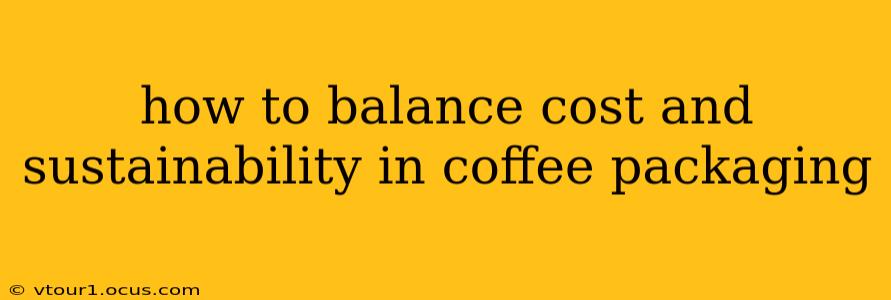The aroma of freshly brewed coffee is a daily ritual for millions, but the journey from bean to cup often leaves a significant environmental footprint. Coffee packaging plays a crucial role in this journey, presenting a challenge: how to balance cost-effectiveness with sustainable practices? This comprehensive guide explores the complexities of this issue, offering practical solutions for roasters, brands, and consumers alike.
What are the Main Sustainability Concerns in Coffee Packaging?
The primary environmental impacts of coffee packaging stem from the materials used, their production, transportation, and disposal. Traditional packaging, often relying on single-use plastics and non-recyclable materials, contributes significantly to landfill waste and greenhouse gas emissions. The challenge lies in finding alternatives that minimize these impacts without compromising product protection and affordability.
What are the Costs Associated with Sustainable Coffee Packaging?
While sustainable options offer long-term environmental benefits, they often come with a higher upfront cost. This is due to several factors:
- Material Costs: Biodegradable and compostable materials, such as plant-based plastics or recycled paper, typically cost more than conventional petroleum-based plastics.
- Production Processes: Sustainable packaging often requires more energy-intensive or specialized manufacturing processes, further increasing production expenses.
- Logistics and Transportation: Depending on the source of sustainable materials, transportation costs might be higher.
- Consumer Education and Awareness: Investing in communicating the benefits of sustainable packaging to consumers can add to overall expenses.
How Can I Reduce the Environmental Impact of My Coffee Packaging?
Choosing sustainable packaging involves a multifaceted approach:
1. Material Selection: Exploring Eco-Friendly Options
- Recycled Paper/Cardboard: A readily available and relatively inexpensive option, especially when sourced from responsibly managed forests. Consider using recycled content with high post-consumer waste percentages.
- Bioplastics: Derived from renewable resources like corn starch or sugarcane, these offer a biodegradable alternative to traditional plastics. However, compostability can vary greatly, so check certifications.
- Compostable Packaging: Materials that break down completely in industrial composting facilities. Look for certifications like BPI (Biodegradable Products Institute) for assurance.
- Reusable Packaging: While requiring a higher initial investment, reusable containers can significantly reduce long-term waste. This may involve a deposit-return system or incentivizing customers to return packaging.
2. Reducing Packaging Weight and Volume
Minimizing the amount of material used directly lowers costs and environmental impact. Optimizing packaging design, using lightweight materials, and eliminating unnecessary layers can lead to significant savings.
3. Improving Packaging Design for Recyclability
Even with sustainable materials, proper design is critical for effective recycling. Using clear labeling, separating different materials, and designing for easy separation are essential steps.
4. Sourcing Sustainable Materials Responsibly
Consider the entire supply chain. Look for suppliers committed to responsible forestry practices, fair labor standards, and minimizing environmental impacts during material production and transportation.
What are the Different Types of Sustainable Coffee Packaging Available?
Several sustainable options exist, each with advantages and disadvantages:
- Kraft Paper Bags: A popular choice, but can be less robust than other options and may require additional liners for optimal coffee preservation.
- Stand-Up Pouches with Bioplastic Liners: Offer excellent barrier properties for coffee freshness but need careful consideration of liner compostability.
- Glass Jars: Reusable and highly recyclable, offering excellent protection, but are heavier and more fragile.
How Can I Choose the Right Sustainable Coffee Packaging for My Business?
The best choice depends on your budget, the specific needs of your coffee (e.g., roast level, grind size), your target market, and your overall sustainability goals. A life-cycle assessment (LCA) can be valuable in comparing the environmental impacts of different options.
How Much More Expensive is Sustainable Coffee Packaging?
The price difference varies widely based on the chosen materials and production methods. Expect to pay a premium compared to conventional packaging, but the cost difference should be weighed against the long-term environmental and potentially brand reputation benefits.
What are the Benefits of Using Sustainable Coffee Packaging?
Beyond the environmental advantages, sustainable packaging offers other benefits:
- Enhanced Brand Image: Consumers are increasingly conscious of environmental issues, and choosing sustainable packaging can attract environmentally conscious customers.
- Increased Customer Loyalty: Demonstrating a commitment to sustainability can foster strong customer relationships and loyalty.
- Meeting Growing Regulatory Requirements: Many regions are enacting stricter regulations regarding packaging waste, and sustainable options help businesses comply.
Balancing cost and sustainability in coffee packaging requires careful planning and consideration. By prioritizing material selection, design optimization, and responsible sourcing, coffee companies can create packaging that minimizes their environmental footprint without compromising affordability or product quality. The future of coffee packaging lies in innovative solutions that integrate both economic and ecological considerations, leading to a more sustainable coffee experience for all.
